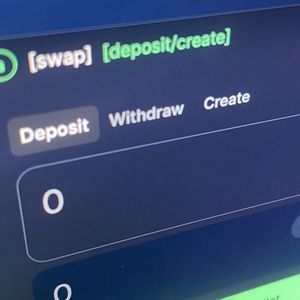Running smart contracts on Bitcoin with Tap Protocol Q&A with Head of Marketing Neil Fitzhugh
10 min read
After the sixth edition of the Paris Blockchain Week wrapped up at the iconic Carrousel du Louvre, we can’t help but reminisce on the event, which drew over 9,600 attendees, including C-suite executives from around the world. Cryptopolitan had the pleasure of being one of the brands represented at the event alongside notable mentions like Google, Trust Wallet, Mercedes, Binance, and Spotify, among others. Our team had the opportunity to witness firsthand the impact and potential of blockchain across various industries. Today, we revisit some of the engaging interviews we had with some thought-provoking leaders in the space. This interview, held by Frederick Mitchell, explores the Tap Protocol with its head of marketing, Neil Fitzhugh. The article is an eye-opener, particularly for the Bitcoin ecosystem and Tap’s role in helping secure the future of the Bitcoin ecosystem. Background Q: Please describe your background and role at Tap and what attracted you to the project. A: I’ve been in Bitcoin since 2017. At that point, you bought Bitcoin. You held Bitcoin, and there’s nothing much you could do with Bitcoin. I started following a guy named Raoul Pal. He had a platform called Real Vision and talked about NFTs. I bought some NFTs and tokens, but I lost some money and realized I’m not a trader. But the education was invaluable. I started working full-time in the space in 2021. I joined an Ethereum play-to-earn basketball game out in LA. About six months later, the company died in the bear market. Luckily, I met a British entrepreneur called Sam Jones, who was building a Web3 social commerce app. I joined them for about a year as head of creator relations. I then did some consulting with my favorite NFT collection on Ethereum, now on Bitcoin, and Ordinals. About a year ago, I joined Track Systems, the group that built Tap Protocol and Track Network. Q: What attracted you to Tap Protocol? A: So, Bitcoin is a passion. As I mentioned, you can only hold Bitcoin and do nothing with it. Just over two years ago, we had the Ordinal protocol. For anybody who’s not aware, you could suddenly do things like NFTs on Bitcoin. On top of that protocol (Ordinals), you could build smart contracts. You could now do any kind of thing that you experience in a Solana or an Ethereum environment on Bitcoin, whether it’s gaming, metaverse, or DeFi. What attracted me to TAP is that everything is layer one. Everything is native assets. It’s not synthetic assets on an L2 or a multisignature architecture that makes it less secure and decentralized. It’s pure Bitcoin, and the users have complete ownership of their assets. Q: Please provide some background on the project, how it started, its progress, and the roadmaps. A: TAP protocol is the most programmable Bitcoin protocol; you can have Turing-complete smart contracts as you would have on Ethereum or Solana. You can manipulate, move, and manage native Bitcoin and Bitcoin assets to Ordinals or other fungible tokens. Q: When was the group founded? A: The group was founded in 2023. TRAC Systems is the company. The TAP protocol went live in 2023. The Token Generation Event (TGE) happened later; we launched with CoinList in July 2024. How the Tap Protocol works Q: How does the tech stack work, and how does it operate with Bitcoin? A: There are many ways to do DeFi on Bitcoin. We didn’t want anybody to take a native Bitcoin asset and lock it, and have to trust an additional entity. So we pioneered Bitcoin L1 co-processing. The protocol is built so the smart contracts from other major L1’s, for example, ICP, Cardano, Tron, Solana, Ethereum, plug their smart contracts and manipulate the Bitcoin assets on Bitcoin without needing anybody to send them elsewhere and take that additional risk, or use synthetic assets on a layer two. Q: How does the token fit into the ecosystem? A: It’s key to understand that this is the Bitcoin network, and Bitcoin is its native token. So, TAP is a utility token on Tap Protocol applications like the Ethereum bridge, Tron bridge, and DEX (Decentralized Exchange). TAP token is integrated into products to reduce fees on things like bridging assets to Ethereum or TRON. We have a decentralized physical infrastructure, a DePIN , and a GPU network being built for AI swarms, and they’re integrating the TAP token. It’s not a governance token. Why Bitcoin: Challenges and advantages of building on Bitcoin Q: What are the advantages of using Bitcoin A: Bitcoin is the most secure, most decentralized chain. From a brand perspective, it’s the most recognized brand. There’s a lot of wealth around the Bitcoin ecosystem that’s only growing, but nothing to do with your Bitcoin. You don’t want to trust your Bitcoin by wrapping or bridging it and sending it into another ecosystem, which could be risky. A lot of wealth and money want to participate in these types of things from a user perspective, but they do not have the ability to. Q: What are the difficulties? A: Bitcoin has a more difficult architecture to build on because you can’t just launch a smart contract directly on Bitcoin. You have to find unique solutions to that. So, the chain is more difficult and has less history of building complex apps. Two, there’s an educational barrier: people don’t think smart contracts are possible with Bitcoin. So, in terms of adoption and new users, it will only accelerate. But in the first two years, it has been a slow burn rather than an explosion of activity. Although there was a huge explosion of activities with Ordinals, DeFi hasn’t fully taken off because of these friction points. The other challenge is education around the people who own Bitcoin. Bitcoin maxis would say, ‘Well, I don’t ever want to be able to do anything with my Bitcoin.’ People still disagree on whether Bitcoin should be used for more programmable use cases, such as apps and DeFi. Q: What do you say to those who regard Bitcoin as Internet gold? Those who leave it in the vault and don’t touch it. What do you say to those people to encourage them to engage with Bitcoin being built as a more complete ecosystem? A: Bitcoin needs users to reward the miners, so it needs activity on the chain. The block space isn’t filled as much these days as it can be. That shows us that rewards to miners can decrease, and if their financial interest is to protect and decentralize this network, through how much money they’ll receive in rewards in Bitcoin, if they’re not making money, they will go and mine on other chains. You need more activity to sustain the greatest technological invention of all time: banking the unbanked in many parts of the world. A mechanism on Tap protocol went live on the Bitcoin blockchain, allowing miners to earn a new token in addition to the standard Bitcoin reward. It’s called dmt-nat, a new type of asset on Bitcoin. Bitcoin can trigger assets. So all these assets are now being triggered in every single block. But, bots were coming and scooping them all up. That doesn’t help Bitcoin, right? What does help Bitcoin is if you redirect those actual tokens into the wallets of whoever mines the block. This is an example of why DeFi on Bitcoin. In 2140, when the last piece of Bitcoin is mined and there is no financial reward, these miners will turn off their computers, stop investing in electricity, and stop producing Bitcoin, and everything will go to zero. So, at a deeper level, this is what Tap is helping to solve. We are the first ever to do this. Miners now have a literal second subsidy in their wallets every single time they mine a block, and that will only increase all the time. Q: Is it fair to say that without DeFi on Bitcoin, the whole ecosystem will cease functioning? A: DeFi alone will not guarantee it. Without additional revenue streams for miners, Bitcoin won’t be as secure, and it will lose the very properties that make it what it is. Programmability on Bitcoin enables the ability to drive more use cases to the chain, which drives more income to the miners. Yes, it would trend to zero because what’s the incentive to mine if there’s no income? Q: Have you seen any issues with regard to security? A: Not one transaction on the protocol. For assets to be compromised, you would have to compromise an L1. For example, if we use ICP, the first L1 we partnered with and pioneered the smart contracts themselves, we can create a Bitcoin wallet. It shares the security key with all of the nodes within that network. All of these nodes in that network are run by people who are KYC’d by ICP because that’s how their ecosystem works. You would have to compromise each person running these separate nodes. It’s all completely cryptographically secured by ICP’s architecture. You need to compromise all of them; they have a legal responsibility and are legally registered. So they’d have to risk all the legal implications as well. So it is as trust-minimized as you can get. Platform products and functionalities Q: What are some of your products and functionalities that people can do with Tap Protocol? A: We helped build the automated market maker of Taparoo Swap. They did the engine that you have within any decentralized exchange. Benny, the founder of Tap, helped build that. Taparoo Swap is the first decentralized exchange on Bitcoin. For example, we have a bridge with Ethereum. We have stablecoin pairs like USDT and USDC within the pools, liquidity pools, and peer-to-peer swaps. Taparoo is a flagship product on tap because it demonstrates the power of fully decentralized smart contracts for L1 core processing. Q: Can people start engaging in all the DeFi aspects that have been missing from Bitcoin on Tap Protocol? A: Absolutely. This DEX has been available for at least half a year, so the pools are open. Any tokens that upgrade on that protocol can be traded against each other. As I mentioned, major stables like USDT and USDC are already here, the backbone of any DeFi ecosystem. Q: For somebody interested in this, they’ve been hoarding Bitcoin and are now looking to do something with it. What do they do? What’s the best course of action? A: Well, one of the best examples is Taparoo Swap. You can contribute and deposit Bitcoin into a liquidity pool, and as people trade against that, you earn a percentage of the fees. Tap has not launched a major lending protocol yet, but it is working towards that. The lending protocol will be fully custodial, and when you lend Bitcoin to somebody else, you’ll earn interest from them. Q: What yields can people expect? A: The yields will change depending on the activity. It’s dependent on volume within the ecosystem, so the rate is variable. This will never be locked, though. People can put their Bitcoin in and out and have full custody and control. Q: Are there any other products or aspects of Tap Protocol that you would like to highlight and bring to our readers’ attention? A: I’ve mentioned a few verticals, such as metaverse and gaming. These things are on Ethereum, and people might not be aware that they are already live on Bitcoin. The gaming metaverse is huge on Bitcoin, not in terms of adoption but in terms of the builders working towards this, and there are many of them building on Tap. There are entirely new kinds of NFTs that you can build, and they’re called ordinals. But there are even different subcategories within ordinals. There’s something called digital matter, DMT, collectibles. You can create assets on Bitcoin via the Tap Protocol. So, you would write the code for your collection and then inscribe it on Bitcoin. But depending on which part of a Bitcoin block you want to attach your smart contract to. That property of Bitcoin is what will trigger the assets. So if that particular pattern of data happens again on Bitcoin, it will trigger assets. Our art is also big. We have launch pads. If you think of a product you can build on Ethereum, you can now build it on TAP. Future prospects Q: How do you think you can continue adding value to Bitcoin and keep it growing? A: We have bridges with Ethereum, bridges with Tron, and bridges with other chains that will continue. Some people might not want to use the ten-minute blocks. For example, with DeFi, some users want instant finality. They want to be able to go to these things quickly. So, the other part of the Trac Systems group is a blockless L1 called Trac Network. You don’t need blocks. Having blocks stops these things from scaling. So, you can build apps on a decentralized platform with the same security, decentralization, and consensus we have with blockchains, but you can build apps on there that are way faster, way cheaper, and way more scalable. They don’t have the issues of fees going up when many people try to use it. And because we also built the Tap Protocol within the group, these two things are integrated. There is Hypermall, a super-fast trading platform on the track network that supports any asset in the TAP protocol. Q: It’s difficult to understand why Bitcoin is correlated with traditional financial markets. Is what you are doing a key element to decouple it from traditional financial markets? A: A lot of us in the room share that sentiment. There’s a lot of wealth tied to Bitcoin. The more people can do with it, the more securely they can earn within a financial ecosystem, whether Web2 or Web3. This will attract businesses, builders, users, and economies. So, the TAP protocol is at the center of this right now. We want to allow people to do all these things with complex financial instruments to earn a yield on their assets and Bitcoin without taking those additional risks we discussed earlier.

Source: Cryptopolitan



